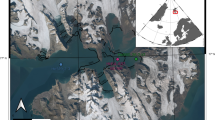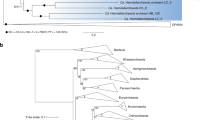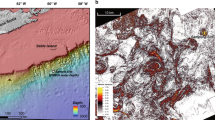Abstract
The evolution of oxygenic photosynthesis had a profound impact on the Earth’s surface chemistry, leading to a sharp rise in atmospheric oxygen between 2.45 and 2.32 billion years (Gyr) ago1,2 and the onset of extreme ice ages3. The oldest widely accepted evidence for oxygenic photosynthesis has come from hydrocarbons extracted from ∼2.7-Gyr-old shales in the Pilbara Craton, Australia, which contain traces of biomarkers (molecular fossils) indicative of eukaryotes and suggestive of oxygen-producing cyanobacteria4,5,6,7. The soluble hydrocarbons were interpreted to be indigenous and syngenetic despite metamorphic alteration and extreme enrichment (10–20‰) of 13C relative to bulk sedimentary organic matter5,8. Here we present micrometre-scale, in situ 13C/12C measurements of pyrobitumen (thermally altered petroleum) and kerogen from these metamorphosed shales, including samples that originally yielded biomarkers. Our results show that both kerogen and pyrobitumen are strongly depleted in 13C, indicating that indigenous petroleum is 10–20‰ lighter than the extracted hydrocarbons5. These results are inconsistent with an indigenous origin for the biomarkers. Whatever their origin, the biomarkers must have entered the rock after peak metamorphism ∼2.2 Gyr ago9 and thus do not provide evidence for the existence of eukaryotes and cyanobacteria in the Archaean eon. The oldest fossil evidence for eukaryotes and cyanobacteria therefore reverts to 1.78–1.68 Gyr ago and ∼2.15 Gyr ago10,11, respectively. Our results eliminate the evidence for oxygenic photosynthesis ∼2.7 Gyr ago and exclude previous biomarker evidence for a long delay (∼300 million years) between the appearance of oxygen-producing cyanobacteria and the rise in atmospheric oxygen 2.45–2.32 Gyr ago1.
This is a preview of subscription content, access via your institution
Access options
Subscribe to this journal
Receive 51 print issues and online access
$199.00 per year
only $3.90 per issue
Buy this article
- Purchase on Springer Link
- Instant access to full article PDF
Prices may be subject to local taxes which are calculated during checkout



Similar content being viewed by others
References
Bekker, A. et al. Dating the rise of atmospheric oxygen. Nature 427, 117–120 (2004)
Canfield, D. E. The early history of atmospheric oxygen. Annu. Rev. Earth Planet. Sci. 33, 1–36 (2005)
Kopp, R. E., Kirschvink, J. L., Hilburn, I. A. & Nash, C. Z. The Paleoproterozoic snowball Earth: a climate disaster triggered by the evolution of oxygenic photosynthesis. Proc. Natl Acad. Sci. USA 102, 11131–11136 (2005)
Brocks, J. J., Logan, G. A., Buick, R. & Summons, R. E. Archean molecular fossils and the early rise of eukaryotes. Science 285, 1033–1036 (1999)
Brocks, J. J., Buick, R., Logan, G. A. & Summons, R. E. Composition and syngeneity of molecular fossils from the 2.78 to 2.45 billion-year-old Mount Bruce Supergroup, Pilbara Craton, Western Australia. Geochim. Cosmochim. Acta 67, 4289–4319 (2003)
Brocks, J. J., Buick, R., Summons, R. E. & Logan, G. A. A reconstruction of Archean biological diversity based on molecular fossils from the 2.78 to 2.45 billion-year-old Mount Bruce Supergroup, Hamersley Basin, Western Australia. Geochim. Cosmochim. Acta 67, 4321–4335 (2003)
Summons, R. E., Jahnke, L. L., Hope, J. M. & Logan, G. A. 2-Methylhopanoids as biomarkers for cyanobacterial oxygenic photosynthesis. Nature 400, 554–557 (1999)
Hayes, J. M., Kaplan, I. R. & Wedeking, K. W. in Earth’s Earliest Biosphere: Its Origin and Evolution (ed. Schopf, J. W.) 93–134 (Princeton Univ. Press, 1983)
Rasmussen, B., Fletcher, I. R. & Sheppard, S. Isotopic dating of the migration of a low-grade metamorphic front during orogenesis. Geology 33, 773–776 (2005)
Knoll, A. H., Javaux, E. J., Hewitt, D. & Cohen, P. Eukaryotic organisms in Proterozoic oceans. Phil. Trans. R. Soc. B 361, 1023–1038 (2006)
Hofmann, H. J. Precambrian microflora, Belcher Islands, Canada: Significance and systematics. J. Paleontol. 50, 1040–1073 (1976)
Brocks, J. J., Grosjean, E. & Logan, G. A. Assessing biomarker syngeneity using branched alkanes with quaternary carbon (BAQCs) and other plastic contaminants. Geochim. Cosmochim. Acta 72, 871–888 (2008)
Hayes, J. M. in Early Life on Earth (ed. Bengtson, S.) 220–236 (Columbia Univ. Press, 1994)
Hinrichs, K.-U. Microbial fixation of methane carbon at 2.7 Ga: was an anaerobic mechanism possible? Geochem. Geophys. Geosyst. 3, 1–10 (2002)
Hoefs, J. Stable Isotope Geochemistry 158 (Springer, 2004)
Fletcher, I. R., Kilburn, M. R. & Rasmussen, B. NanoSIMS µm-scale in situ measurement of 13C/12C in early Precambrian organic matter, with permil precision. Int. J. Mass Spec. (in the press)
Rasmussen, B. Evidence for pervasive petroleum generation and migration in 3.2 and 2.63 billion-year old shales. Geology 33, 497–500 (2005)
Smith, R. E., Perdrix, J. L. & Parks, T. C. Burial metamorphism in the Hamersley Basin, Western Australia. J. Petrol. 23, 75–102 (1982)
Des Marais, D. J. in Stable Isotope Geochemistry (eds Valley, J. W. & Cole, D. R.) 555–578 (Reviews in Mineralogy and Geochemistry, Vol. 43, Mineralogical Society of America, 2001)
Crick, I. H., Boreham, C. J., Cook, A. C. & Powell, T. G. Petroleum geology and geochemistry of middle Proterozoic McArthur Basin, northern Australia II: assessment of source rock potential. Am. Assoc. Petrol. Geol. Bull. 72, 1495–1514 (1988)
Summons, R. E., Powell, T. G. & Boreham, C. J. Petroleum geology and geochemistry of the middle Proterozoic McArthur Basin, northern Australia: III. Composition of extractable hydrocarbons. Geochim. Cosmochim. Acta 52, 1747–1763 (1988)
Hunt, J. M. Petroleum Geochemistry and Geology (Freeman, 1995)
Rasmussen, B., Fletcher, I. R., Muhling, J. R., Thorne, W. S. & Broadbent, G. C. Prolonged history of episodic fluid flow in giant hematite ore bodies: Evidence from in situ U-Pb geochronology of hydrothermal xenotime. Earth Planet. Sci. Lett. 258, 249–259 (2007)
Sherman, L. S., Waldbauer, J. R. & Summons, R. E. Improved methods for isolating and validating indigenous biomarkers in Precambrian rocks. Org. Geochem. 38, 1987–2000 (2007)
Dutkiewicz, A., Volk, H., George, S. C., Ridley, J. & Buick, R. Biomarkers from Huronian oil-bearing fluid inclusions: An uncontaminated record of life before the Great Oxidation Event. Geology 34, 437–440 (2007)
George, S. C., Volk, H., Dutkiewicz, A., Ridley, J. & Buick, R. Preservation of hydrocarbons and biomarkers in oil trapped inside fluid inclusions for >2 billion years. Geochim. Cosmochim. Acta 72, 844–870 (2008)
Kump, L. R. & Barley, M. E. Increased subaerial volcanism and the rise of atmospheric oxygen 2.5 billion years ago. Nature 448, 1033–1036 (2007)
Goldblatt, C., Lenton, T. M. & Watson, A. J. Bistability of atmospheric oxygen and the Great Oxidation. Nature 443, 683–686 (2006)
Anbar, A. D. et al. A whiff of oxygen before the Great Oxidation Event? Science 317, 1903–1906 (2007)
Konhauser, K. O. et al. Could bacteria have formed the Precambrian banded iron formations? Geology 30, 1079–1082 (2002)
Slodzian, G., Chaintreau, M., Dennebouy, R. & Rousse, G. Precise in situ measurements of isotopic abundances with pulse counting of sputtered ions. Eur. Physical J. Appl. Physics 14, 199–232 (2001)
Slodzian, G., Hillion, F., Stadermann, F. J. & Zinner, E. QSA influences on isotopic ratio measurements. Appl. Surf. Sci. 231–232, 874–877 (2004)
Hillion, F., Kilburn, M. R., Hoppe, P., Messenger, S. & Weber, P. K. The effect of QSA on S, C, O and Si isotopic ratio measurements. Geochim. Cosmochim. Acta 72, A377 (2008)
Acknowledgements
We thank S. Bengtson, G. A. Logan, J. R. Muhling, S. Revets and S. Sheppard for discussion and comments; and A. C. Cook for organic reflectivity measurements. We acknowledge the facilities of the Australian Microscopy and Microanalysis Research Facility at the Centre for Microscopy, Characterisation and Analysis, University of Western Australia, a facility funded by the University, State and Commonwealth Governments.
Author information
Authors and Affiliations
Corresponding author
Supplementary information
Supplementary Information
This file contains Supplementary Tables 1and 2 with Legends, Supplementary Figure 1 and Supplementary References (PDF 303 kb)
Rights and permissions
About this article
Cite this article
Rasmussen, B., Fletcher, I., Brocks, J. et al. Reassessing the first appearance of eukaryotes and cyanobacteria. Nature 455, 1101–1104 (2008). https://doi.org/10.1038/nature07381
Received:
Accepted:
Issue Date:
DOI: https://doi.org/10.1038/nature07381
This article is cited by
-
Neomicrocoleus gen. nov. (Microcoleaceae, Oscillatoriales), a novel cyanobacterial genus from benthic mats in a water channel
Journal of Oceanology and Limnology (2024)
-
Phylotranscriptomics unveil a Paleoproterozoic-Mesoproterozoic origin and deep relationships of the Viridiplantae
Nature Communications (2023)
-
Microbial applications for sustainable space exploration beyond low Earth orbit
npj Microgravity (2023)
-
Perceptions of Freshwater Algal Blooms, Causes and Health among New Brunswick Lakefront Property Owners
Environmental Management (2023)
-
Photosynthetic microalgae–based carbon sequestration and generation of biomass in biorefinery approach for renewable biofuels for a cleaner environment
Biomass Conversion and Biorefinery (2023)
Comments
By submitting a comment you agree to abide by our Terms and Community Guidelines. If you find something abusive or that does not comply with our terms or guidelines please flag it as inappropriate.



